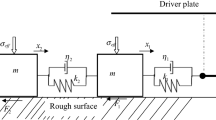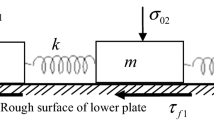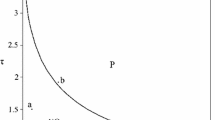Abstract
In present paper, an effect of delayed frictional healing on complex dynamics of simple model of earthquake nucleation is analyzed, following the commonly accepted assumption that frictional healing represents the main mechanism for fault restrengthening. The studied model represents a generalization of Burridge–Knopoff single-block model with Dieterich–Ruina’s rate and state dependent friction law. The time-dependent character of the frictional healing process is modeled by introducing time delay τ in the friction term. Standard local bifurcation analysis of the obtained delay-differential equations demonstrates that the observed model exhibits Ruelle–Takens–Newhouse route to chaos. Domain in parameters space where the solutions are stable for all values of time delay is determined by applying the Rouché theorem. The obtained results are corroborated by Fourier power spectra and largest Lyapunov exponents techniques. In contrast to previous research, the performed analysis reveals that even the small perturbations of the control parameters could lead to deterministic chaos, and, thus, to instabilities and earthquakes. The obtained results further imply the necessity of taking into account this delayed character of frictional healing, which renders complex behavior of the model, already captured in the case of more than one block.






Similar content being viewed by others
References
Bolt, A.B.: Earthquakes. Freeman, New York (2003)
Scholz, C.H.: The Mechanics of Earthquakes and Faulting. Cambridge University Press, Cambridge (2002)
Marone, C.: Laboratory derived friction laws and their application to seismic faulting. Annu. Rev. Earth Planet. Sci. 26, 643–696 (1998)
Dieterich, J.H.: Modeling of rock friction: 1; experimental results and constitutive equations. J. Geophys. Res. 84, 2161–2168 (1979)
Ruina, A.L.: Slip instability and state variable friction laws. J. Geophys. Res. 88, 10359–10370 (1983)
Perrin, G., Rice, J.R., Zheng, G.: Self-healing slip pulse on a frictional surface. J. Mech. Phys. Solids 43, 1461–1495 (1995)
Rabinowicz, E.: The intrinsic variables affecting the stick-slip process. Proc. Phys. Soc. Lond. 71, 668–675 (1958)
Tolstoi, D.M.: Significance of the normal degree of freedom and natural normal vibrations in contact friction. Wear 10, 199–213 (1967)
Pomeau, Y., Le Berre, M.: Critical speed-up vs critical slow-down: a new kind of relaxation oscillation with application to stick-slip phenomena (2011). arXiv:1107.3331v1
Burridge, R., Knopoff, L.: Model and theoretical seismicity. Bull. Seismol. Soc. Am. 57, 341–371 (1967)
Dieterich, J.H.: A model for the nucleation of earthquake slip. In: Das, S., Boatwright, J., Scholz, C. (eds.) Earthquakes Source Mechanics. Geophys. Monogr. Ser., vol. 37, pp. 36–49. Am. Geophys. Union, Washington (1986)
Dieterich, J.H.: Earthquake nucleation on faults with rate-and state-dependent strength. Tectonophysics 211, 115–134 (1992)
Scholz, C.H., Aviles, C.A., Wesnousky, S.G.: Scaling differences between large interplate and intraplate earthquakes. Bull. Seismol. Soc. Am. 76, 65–70 (1986)
Marone, C., Vidale, J.E., Ellsworth, W.: Fault healing inferred from time dependent variations in source properties of repeating earthquakes. Geophys. Res. Lett. 22, 3095–3098 (1995)
Marone, C.: The effect of loading rate on static friction and the rate of fault healing during the earthquake cycle. Nature 391, 69–72 (1998)
Ben-David, O., Rubinstein, S.M., Fineberg, J.: Slip-stick and the evolution of frictional strength. Nature 463, 76–79 (2010)
Gopalsamy, K., Leung, I.: Delay induced periodicity in a neural netlet of excitation and inhibition. Physica D 89, 395–426 (1996)
Burić, N., Todorović, D.: Dynamics of delay-differential equations modeling immunology of tumor growth. Chaos Solitons Fractals 13, 645–655 (2002)
De Sousa Vieira, M.: Chaos and synchronized chaos in an earthquake model. Phys. Rev. Lett. 82, 201–204 (1999)
Erickson, B., Birnir, B., Lavallee, D.: A model for aperiodicity in earthquakes. Nonlinear Process. Geophys. 15, 1–12 (2008)
Erickson, B.A., Birnir, B., Lavallée, D.: Periodicity, chaos and localization in a Burridge–Knopoff model of an earthquake with rate-and-state friction. Geophys. J. Int. 187, 178–198 (2011)
Dieterich, J.H., Kilgore, B.D.: Direct observation of frictional contacts: new insights for state dependent properties. Pure Appl. Geophys. 143, 283–302 (1994)
Rice, J.R.: Spatio-temporal complexity of slip on a fault. J. Geophys. Res. 98, 9885–9907 (1993)
Lapusta, N., Rice, J.R.: Nucleation and early seismic propagation of small and large events in a crustal earthquake model. J. Geophys. Res. 108, 1–18 (2003)
Szkutnik, J., Kawecka-Magiera, B., Kulakowski, K.: History-dependent synchronization in the Burridge–Knopoff model. Tribol. Ser. 43, 529–536 (2003)
Engelborghs, K.: DDE-BIFTOOL v. 2.03: a MATLAB package for bifurcation analysis of delay differential equations (2000)
Engelborghs, K., Luzyanina, T., Samaey, G.: Technical report TW-330, Department of Computer Science, K.U. Leuven, Leuven, Belgium (2001)
Luzyanina, T., Enghelborghs, K., Ehl, S., Klenerman, P., Bocharov, G.: Low level viral persistence after infection with LCMV: a quantitative insight through numerical bifurcation analysis. Math. Biosci. 173, 1–23 (2001)
Haegeman, B., Engelborghs, K., Roose, D., Pieroux, D., Erneux, T.: Stability and rupture of bifurcation bridges in semiconductor lasers subject to optical feedback. Phys. Rev. E 66, 046216 (2002)
Belair, J., Campbell, S.A.: Stability and bifurcations of equilibria in a multiple delayed differential equation. SIAM J. Appl. Math. 54, 1402–1424 (1994)
Campbell, S.A., Belair, J., Ohira, T., Milton, J.: Limit cycles, tori and complex dynamics in a second-order differential equation with delayed negative feedback. J. Dyn. Differ. Equ. 7, 213–235 (1995)
Titchmarsh, E.C.: Theory of Functions. Oxford University Press, Oxford (1939)
Hale, J., Lunel, S.V.: Introduction to Functional Differential Equations. Springer, New York (1983)
Wiggins, S.: Introduction to Applied Nonlinear Dynamical Systems and Chaos. Springer, New York (2000)
Kuznetsov, Y.A.: Elements of the Applied Bifurcation Theory. Springer, New York (2004)
Ruelle, D., Takens, F.: On the nature of turbulence. Commun. Math. Phys. 20, 167–172 (1971)
Ramana Reddy, D.V., Sen, A., Johnson, G.L.: Time delay induced death in coupled limit cycle oscillators. Phys. Rev. Lett. 80, 5109–5112 (1998)
Campbell, S.A.: Time delays in neural systems. In: Jirsa, V.K., McIntosh, A.R. (eds.) Handbook on Brain Connectivity, pp. 65–90. Springer, Berlin (2007)
Prasad, A., Dhamala, M., Adhikari, B.M., Ramaswamy, R.: Amplitude death in nonlinear oscillators with nonlinear coupling. Phys. Rev. E 81, 027201 (2010)
Newhouse, S., Ruelle, D., Takens, F.: Occurrence of strange axiom-A attractors near quasiperiodic flow on 7, m>3. Commun. Math. Phys. 64, 35–44 (1978)
Schmittbuhl, J., Vilotte, J.P., Roux, S.: Propagative macrodislocation modes in an earthquake fault model. Europhys. Lett. 21, 375–380 (1993)
Acknowledgements
This research has been supported by the Ministry of Education, Science, and Technological development, Contracts Nos. 176016, 171015, and 171017.
Author information
Authors and Affiliations
Corresponding author
Appendix
Appendix
Starting from the system of equations:
one could obtain:

Thus, we have:
While for the ψ(λ), we obtain:


assuming that |φ(λ)|>|ψ(λ)| on the contour C.
Thus, according to the previous:

Rights and permissions
About this article
Cite this article
Kostić, S., Franović, I., Todorović, K. et al. Friction memory effect in complex dynamics of earthquake model. Nonlinear Dyn 73, 1933–1943 (2013). https://doi.org/10.1007/s11071-013-0914-8
Received:
Accepted:
Published:
Issue Date:
DOI: https://doi.org/10.1007/s11071-013-0914-8




